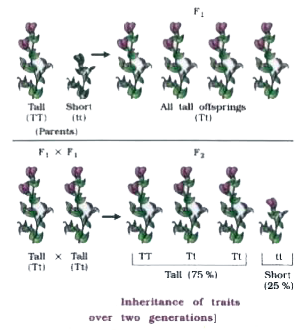The gene ‘T’ for the character of tallness in pea plant is dominant and gene ‘t’ is recessive. Explain it on the basis of Mendel’s experiment.Solution in Gujrati
Mendel selected garden pea plant (Pisum sativum) as an experimental material. The pea plant shows various characters and atleast two contrasting expressions for each of the characters.
Mendel selected height of the pea plant. The two contrasting expressions for the height of pea plants are tall plants and short plants.
Mendel crossed the tall parent (P) plant, (TT), with another short parent (P) plant (tt), and obtained all tall plants in F1 generation. None of the short plants were produced in F1 generation. They were also not of medium height. It means that only one parental characteristic was expressed in the offsprings.
When the plants of F1 generation were allowed to self-pollinate, about 75% plants were tall and about 25% were short in the F2 generation. Thus, the genes for tallness and shortness both are capable of being inherited from the parents of F1 generation.
This indicates that both the tallness and shortness traits were inherited in the F1 plants, but only the tallness trait was expressed.
This led Mendel to propose that two copies of factor (gene) controlling traits are present in sexually reproducing organism.
These two may be identical or may be different.

This experiment indicates that the genes TT or genes Tt is the genetic constitution for tall plants while tt for the short plant. It means that only presence of gene T is responsible for the expression of tallness while the absence of dominant gene T and tt genes produces shortness.
Thus, tallness in pea plant is the dominant trait and shortness is the recessive trait.
Topper's Solved these Questions
- BOOK - KUMAR PRAKASHANCHAPTER - HEREDITY AND EVOLUTIONEXERCISE - TEXTUAL EXERCISE12videos
HEREDITY AND EVOLUTION
- BOOK - KUMAR PRAKASHANCHAPTER - HEREDITY AND EVOLUTIONEXERCISE - ADDITIONAL QUESTIONS AND ANSWERS18videos
HEREDITY AND EVOLUTION
- BOOK - KUMAR PRAKASHANCHAPTER - CONTROL AND COORDINATIONEXERCISE - PRACTICAL SKILL BASED QUESTIONS WITH ANSWERS8videos
CONTROL AND COORDINATION
- BOOK - KUMAR PRAKASHANCHAPTER - HOW DO ORGANISMS REPRODUCE?EXERCISE - PRACTICAL SKILL BASED QUESTIONS WITH ANSWERS5videos
HOW DO ORGANISMS REPRODUCE?
Similar Questions
A Mendelian experiment consisted of breeding tall pea plants bearing violet flowers with short pea plants bearing white flowers. The progeny all bore violet flowers, but almost half of them were short. This suggests that the genetic make-up of the tall parent can be depicted as ……..... a. TTWW b. TTwW c. TtWW d. TtWw
01:38View SolutionDistinguish between :
Acquired characteristics and Hereditary characteristics03:28View SolutionFour different students of your class observed network of neurons in a slide under microscope. They drew a diagram of synaptic junction.
From your knowledge.
Which of the following figures shows the correct pathway for the conduction of impulse ?02:40View SolutionCollect different flowers such as Maize, Sunflower, Papaya, Hibiscus, Datura, Rose, Crinum, etc. Which of them are bisexual ? Draw diagram of any one bisexual flower and state function of each parts.
02:33View SolutionThe genes for which of the following characters in pea plants are syntenic?
01:33View SolutionHow do Mendel’s experiments show that traits may be dominant or recessive?
02:11View SolutionIn Mendel's experiments, there are two alleles of the gene that causes pea shape- R (round) and r (wrinkled) and two alleles of the gene that causes plant height -T (tall ) and t (short). How many different kinds of eggs ae produced by a short plant with wrinkled peas?
04:12View SolutionIn pea plant, the genes for tallness (T) and for green pod colour (G) are dominant and present on separate chromosomes. Its recessive alleles are t and g. What would be the genotype of female gamete of TtGg and of male gamete of TTgg?
03:56View SolutionThe gene for tall pea plant is related with ………..
02:51View SolutionExplain dominant and recessive features on the basis of Mendel's experiments.
02:14View SolutionWhen hybridisation is carried out between a tall (TT) pea plant and a short (tt) pea plant, all the plants (offsprings) show the expression of tallness, because ………………….... a.the expression of tallness is dominant. b.the expression of short is dominant. c.the expression of tallness is recessive. d.the character of tallness in pea plant is not controlled by gene T or t.
02:28View SolutionHow do mendel's experiments show that gene may be dominant or recessive?
04:10View SolutionWhich of the following is best suited for codominance? a) Both genes are recessive b) Both genes are dominant c) One gene is recessive d) One gene is dominant
04:57View SolutionIn Mendel's experiments, tall pea plants (T) are dominant over dwarf pea plants (t).
What is the phenotype and genotype of the F1 generation if a homozygous tall plant is crossed with a homozygous dwarf plant ?03:23View SolutionIn Mendel's experiments, tall pea plants (T) are dominant over dwarf pea plants (t). Draw a Punnett square board to show the gametes and offspring when both the parents are heterozygous for tallness.
02:46View Solution

